I’ve never quite been able to wrap my head around social media advocacy.
It’s scary for me to admit that because I write about social media for a living. I should know these things. I should have everything figured out. And I don’t.
Social media advocacy has eluded me.
Though that hasn’t stopped me from experimenting. I’ve muddled my way through what I believed social media advocacy to mean, and I went so far as to implement advocacy strategies – though not even sure I was doing it right.
And now that I’ve taken a step back and reflected on things, I can see that I’ve had social media advocacy all wrong.
And it’s possible we all have.
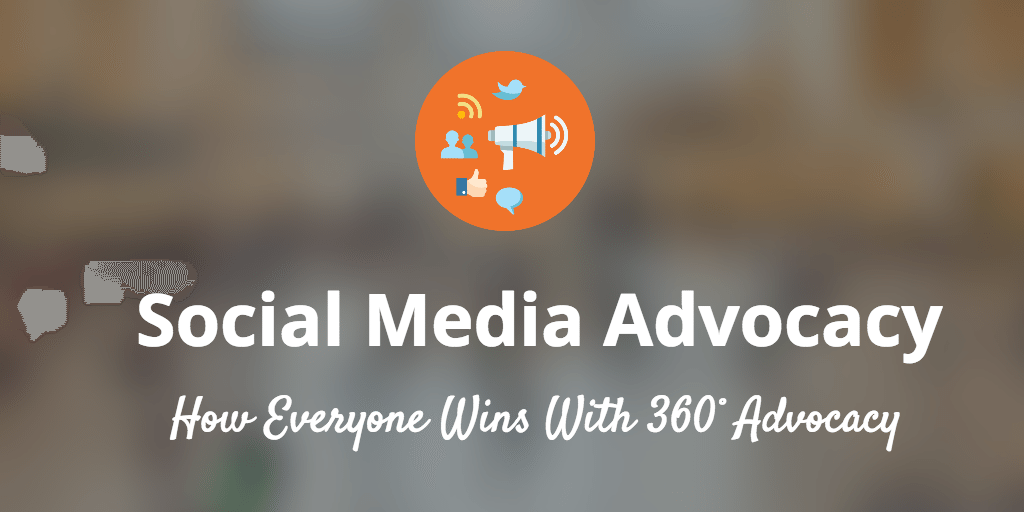
What is social media advocacy? A definition
Personally, I have an audience of a couple thousand on Twitter, Facebook, and others.
Combined, my 40+ Buffer teammates and I have an audience of a few hundred thousand!
This is where social media advocacy becomes super powerful.
The way advocacy works is that you can tap your team to help you spread your content on social media. If you’ve got a new announcement or blog post to share, you and your team can all share it and ramp up the spread and reach of the content.
This can happen organically (by building a team that loves sharing and loves your content) or strategically (by notifying the team when you’ve got new stuff).
Jay Baer has a great slidedeck on the specifics:
Businesses have approached this in a couple of cool ways:
- Employee advocacy – Making it easy for employees to get involved with sharing and promoting
- Ambassador advocacy – Building a group of supporters who can share with you and for you
Cynthia Pflaum collected a neat group of examples of how this has worked for some leading brands. IBM has 500 thought leaders in its IBM Voices advocacy program. Dell has over 10,000 employees who have gone through an internal social media certification program and are trained to support the company’s objectives in social media.
All this is how I had understood advocacy to work. Sorta. And what I’ve realized is that we’ve all been missing the other half of it.
360° Advocacy and the Future of Social Media Advocacy
I believe the current way we approach social media advocacy is incomplete.
And moreso, were we to explore the full possibilities of advocacy, we’d be blown away by the benefits and the effect.
Currently, social media advocacy is a one-way street: Employees advocating for the company. Yet one thing I believe to be true about social media is that our best experiences are always two-way streets. Social media is a two-sided conversation, give-and-take, push-and-pull.
With the current state of social media advocacy, we are pushing.
What amazing things might happen if we were to pull also?
I see this working itself out in two specific ways, forming an overall notion of what I like to call 360° Advocacy.
Here’s the first way, the crusader model:
- Employees or teams advocating for the company. (<– the current model)
- The company advocating for its employees or team.
And here’s the second, the contributor model:
- The company suggests updates to the employee or team. (<– the current model)
- The employee or team suggests updates to the company.
The crusader model
In the crusader model, you take the idea of amplification, which is perhaps the main key benefit of advocacy, and you turn it around. Not only would an employee, for instance, be excited about helping out the business, the business would be excited about helping out the employee.
Say a teammate published an amazing article; the company could share on Facebook. Say someone wrote an inspiring tweet; the company could retweet.
(It can also be as simple and small as retweeting a teammate who shared something about the business—helping recognize the teammate and also promote the business at the same time.)
The contributor model
In the contributor model, you see the mechanics of advocacy replicated also. Not only does the company push updates out to its employees or team, those same individuals can also be contributors to the company, allowing the company to pull in suggested updates from individuals.
For instance, a business could invite suggestions for new content to its social media queues, or it could encourage a team to curate specific topics and come back with contributions.
With me so far? This all is the what of 360° Advocacy. I feel the why might be even more important.
A business is not one person, it is many
This 360° Advocacy requires a bit of a perspective change. So often we’ve read — and I’ve even written — about the benefits of making your business’s presence on social media as human and personable as possible. It makes sense that you’d want your business to fit in like a friend or family member among a News Feed filled with actual friends and family members.
It makes sense, but could it be wrong?
I believe there’s a lot of value still for businesses to find a voice and tone and create a consistent, dependable presence.
I’ve changed my mind to this:
A business feels personal not when it speaks like a person but when it reflects the persons that make up the business.
In other words, businesses don’t need to try to be something they’re not. Fundamentally, they are not a person, they are not a human being.
What they are is a collection of humans.
The individuals that make up the company are what also make the company unique, approachable, relatable. And for a really long time, the best practice for social media marketing has not been about embracing these awesome people. Wow, what a big miss!
With a full view of social media advocacy, I think it raises the question: What if this changed?
What if we began inviting individuals to contribute to the voice of the brand?
What if our feeds stopped looking like this:
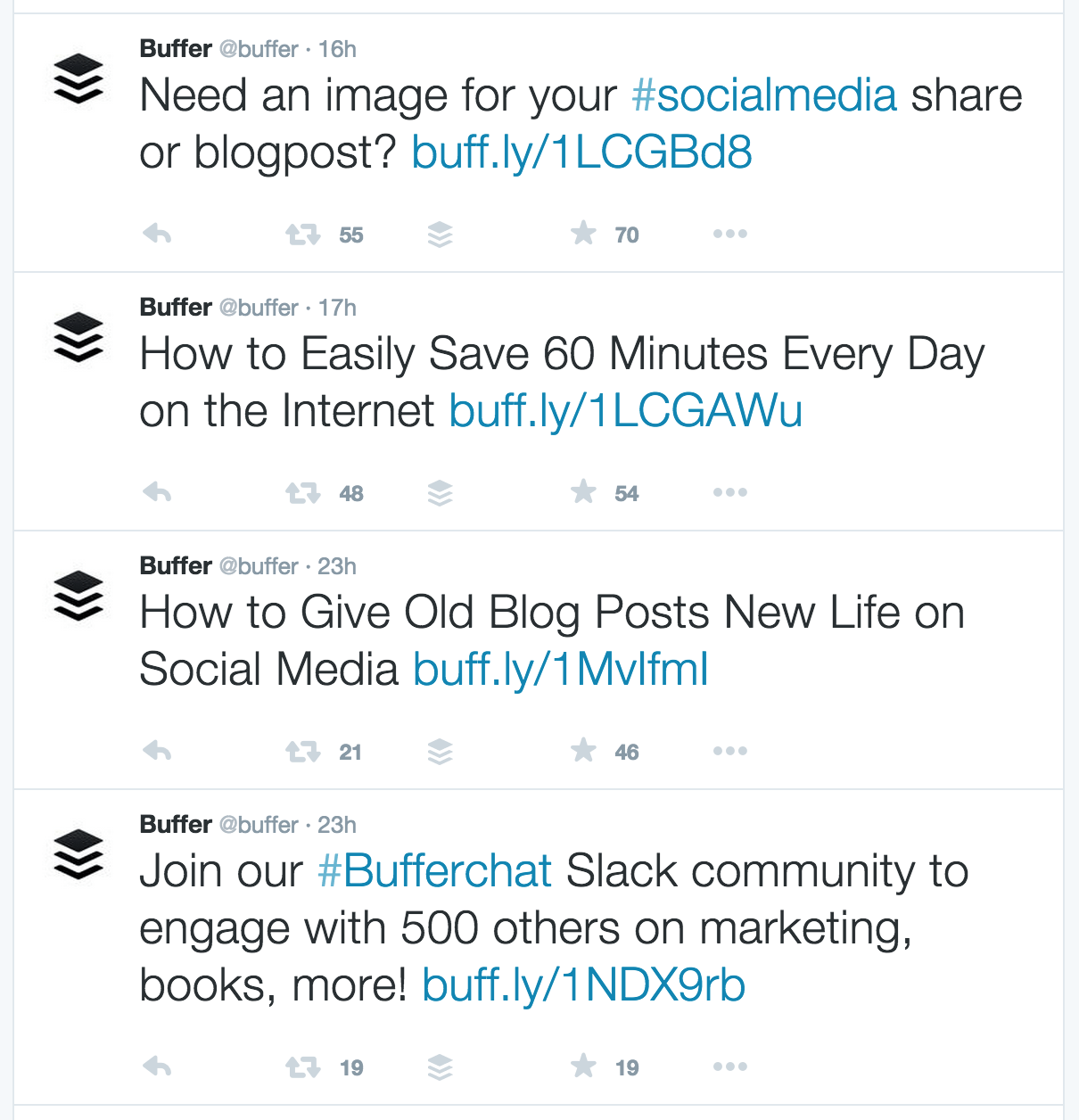
And started looking like this:
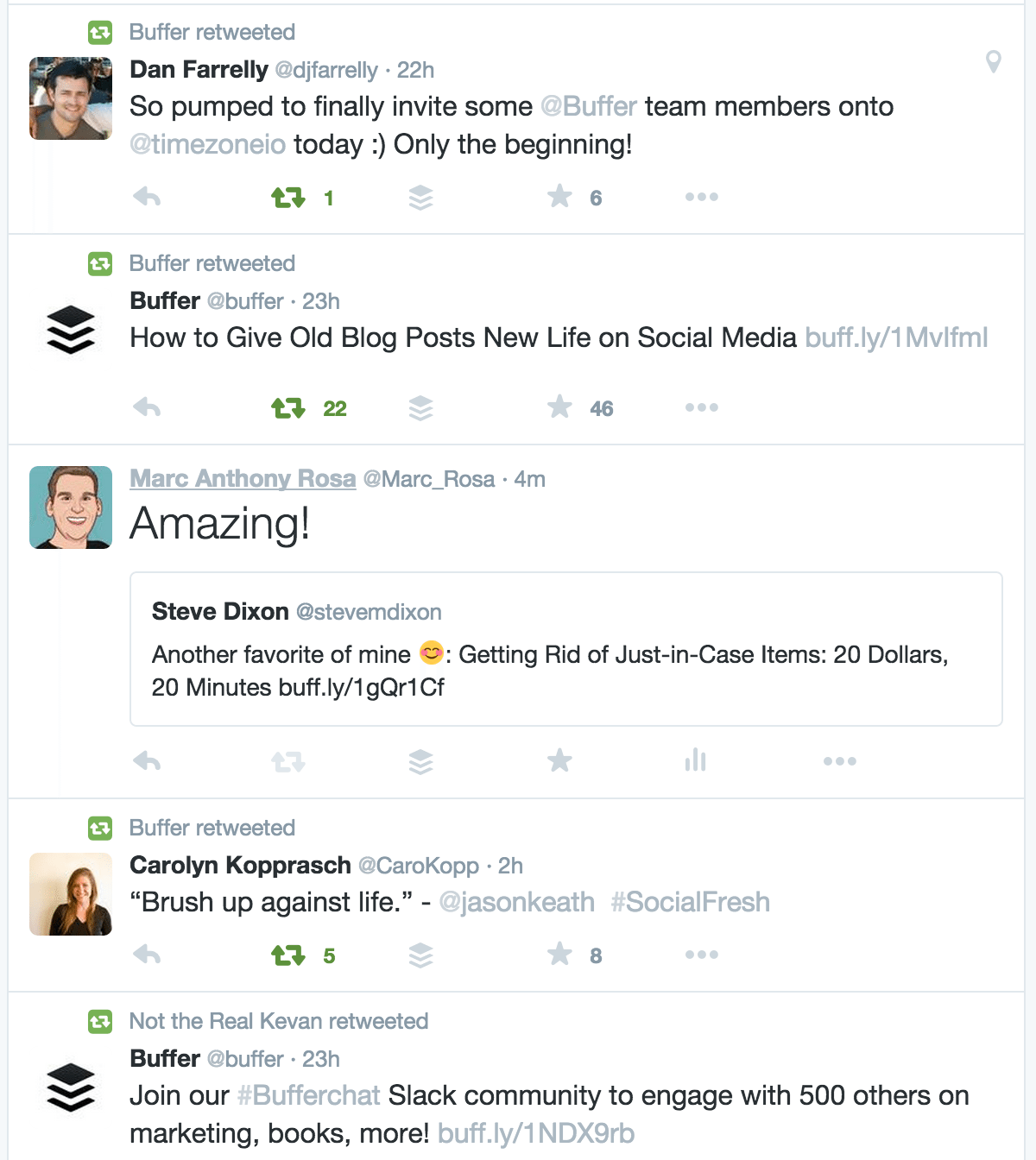
I believe it would be a huge shift in an audience’s perception of a business, where a follower or visitor or community member would no longer see the business in that strange uncanny valley between friend and brand but instead to see the business as exactly what it is: a collection of unique individuals seeking a common goal.
Would you feel a closer bond connecting with a brand like that?
I would, absolutely.
360° Advocacy and the embrace of wholeness
Extraordinary things begin to happen when we dare to bring all of who we are to work.
The above quote comes from Frederic Laloux in his book Reinventing Organizations (a hugely impactful book for all of us here on the Buffer team).
What I find particularly exciting about that quote in the context of advocacy is that I believe those same extraordinary things are possible when a company brings the whole of itself to social media.
The idea of wholeness is quite clear to me when looking at the effect on the workplace (bring your whole self to work). It’s a bit of a jump to make into social media, though it’s a jump I’m excited to take.
Consider this quote from the book, for instance:
Wisdom traditions from around the world speak to this from a deeper level: at heart, we are all profoundly interconnected and part of a whole, but it’s a truth we have forgotten. We are born into separation and raised to feel divided from our deeper nature, as well as from the people and life around us. Our deepest calling in life, these traditions tell us, is to reclaim wholeness, within ourselves and in our connection with the outside world.
My view is that the same has occurred in this divide between brands and individuals on social media.
We are all profoundly interconnected—and to a wonderful degree on social media. We are part of a whole, yet it’s often the case that marketing strategy leads to a purposeful separation of parts of this wholeness, done with the best intentions of course but perhaps missing out on this key element.
We long to feel connected. We struggle to connect with brands.
Why? What’s missing?
I’m beginning to think it could be this element of wholeness.
A company is, after all, a collection of individuals, each with his/her own personality. Yet what we’ve essentially done with our marketing is homogenize these personalities into one.
I feel connected to Wistia because I feel connected to their team, seeing their faces and personalities in the videos they create and share. I feel very much less connected to brands when they’re little more than logos and product pictures.
People connect with people. Brands are filled with people. We can build some great momentum by embracing this wholeness and advocacy in even the smallest way.
(Thanks to my teammate Jeffrey for tying this together with this Thomas the Tank Engine clip.)
https://youtu.be/luOcLuzIn-M?t=3m38s
Does this new kind of advocacy work for huge brands?
The short answer: Probably not, although maybe it should.
Brands spend hundreds of millions of dollars on social media marketing and campaigns, fine-tuning and honing the strategies to every dotted i and crossed t.
Imagine if Coca-Cola, for instance, started retweeting updates from its employees.
That would seem to me as highly aberrant, incredibly quirky, and perhaps even irresponsible. And yet … to a certain degree maybe counterintuitive and quirky is exactly what could endear brands to the people who make up their audience?
It’s difficult to connect on an intimate level with a polished, professional facade.
Perhaps it’d be a bit easier if the facade gave a greater glimpse into its character, personality, and humanity?
Where should you draw the line?
Coca-Cola might not want to go out and share just anything that its team suggests or tweets. And too much variety could even detract from the voice and tone of the company.
There’s likely to be a line between embracing a 3D view of social media advocacy and being strategic with what you share to social media.
And my intuition is that we’re nowhere near the tipping point.
We’ve by and large fallen quite safely onto the highly strategic side.
As with most social media thoughts and recommendations, the best practice is always to test and experiment what works for you. Is there room to include more involvement from your team? Can you humanize your business by including your team as part of who you are?
I’d love to share some ideas on how this could look.
How to get started with 360° Advocacy
There are lots of different ways to take this, and to be honest, it’s quite a bit of an early idea from my side. I’ve yet to explore it fully outside this post, and only in bits and bobs with Buffer. This is how I could see it working. I’d love your thoughts and ideas on other ways, too.
Suggestions – Make it easy to share ideas
We’ve got a neat setup on the Buffer team currently where our co-founder Leo has offered to help surface possible new content that we can share on our personal social media profiles. We do this through Teams, a part of the Buffer for Business plan.
Here’s a bit more about how this looks (with a bonus overview of Groups, which makes team sharing really fast and easy):
With the notion of 360° Advocacy, we could take this to a deeper level. Not only could Leo suggest great articles to my feed, Courtney’s feed, Sandrine’s feed, etc. but also Courtney, Sandrine, and I (plus anyone else!) could suggest great articles that could be shared to the Buffer feed.
With tools like Buffer and others, you can add team members to your social media accounts, and these team members can act as contributors — with the social media manager having the final say on what gets shared, when, and how.
Twitter list – See what your team is sharing
One of my social experiments in the past was retweeting a Buffer teammate once per day from the main Buffer Twitter profile. Sometimes it would be a teammate who had shared a Buffer article or story. Other times it would be a teammate who had an inspiring quite or cool article.
My workflow for this:
- Build a Twitter list of Buffer teammates (I’m grateful that someone before me had laid the foundation here!)
- Visit the Twitter list daily to see what’s being shared
- Click the Buffer button on a tweet to add the retweet to the Buffer queue
- Drag-and-drop within the queue so that a new retweet is scheduled to go each day
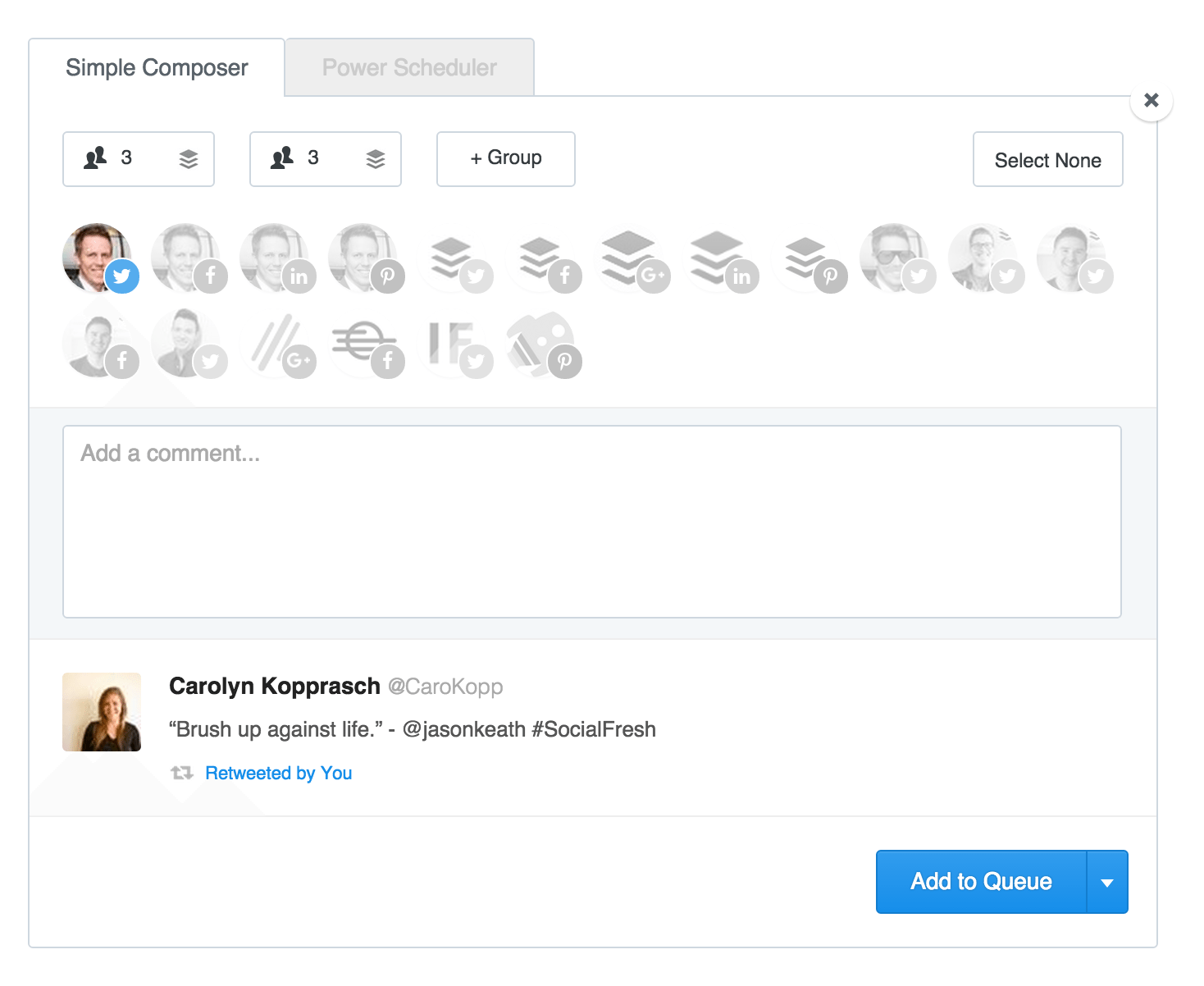
RSS – Find the great stories from your team
It’s possible that a few on your team might have their own blogs and be sharing their own stories and bits of themselves online in cool ways.
We’ve found this to be the case at Buffer. Lots of teammates write blog posts, either on a personal blog or on Medium. We’ll often end up grabbing these to republish on the Open blog as well.
How this might fit with 360° Advocacy is that these pieces of content represent great chances to advocate for your employees or team, to share an extension of your brand by highlighting the amazing people who work for you.
I’ve found a couple neat ways to keep track of this:
1. Send new articles into your team’s chat room (Slack, Hipchat, etc.). We do this via Zapier.

2. Add an RSS feed to Buffer and check it easily from your dashboard. For the Awesome and Business plans, you can add up to 15 RSS feeds per profile and share any new stories to your queue in a single click.
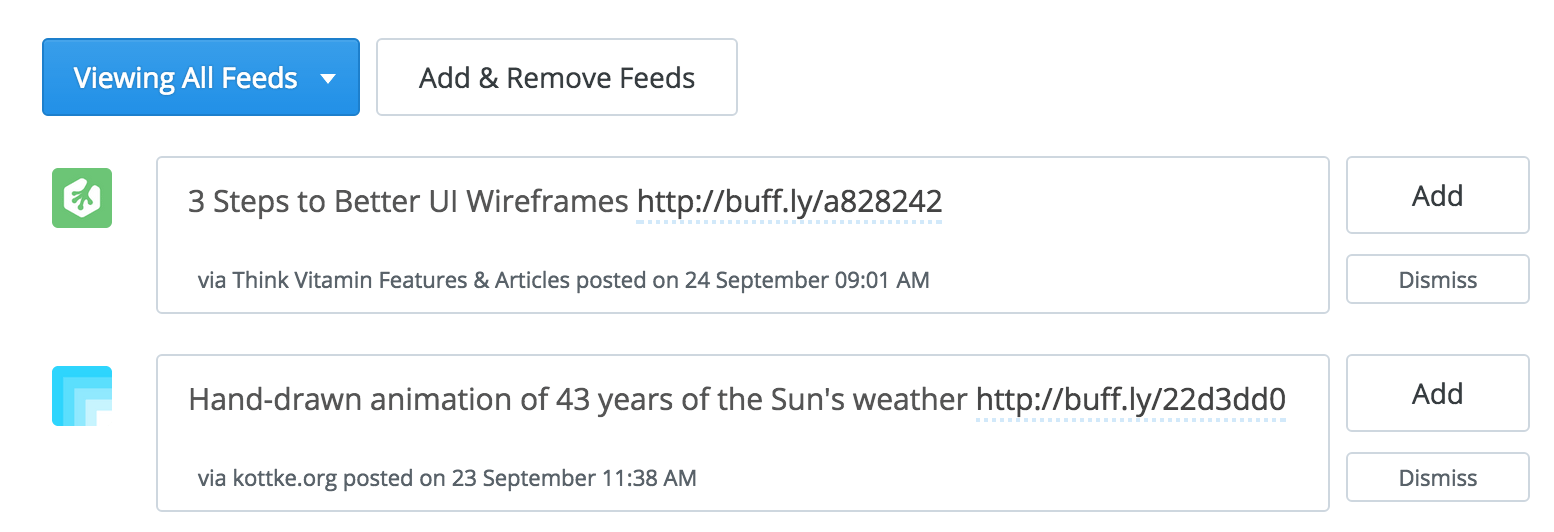
Takeaways
It’s seemed to me that social media advocacy thus far has been heavily focused on helping brands and businesses extend their reach and benefit from the social capital of a big team.
I feel there’s a whole ‘nother side to explore here, too—and potentially some really great benefits for everyone involved.
- Brands can embrace the individuality of their team and become more relatable to their audience
- The team can have a positive impact on the quality and variety of content the brand shares
I’m particularly excited about how wholeness, personality, and diversity can fit into the equation here, too. For all the work we aim to do with refining and perfecting a social media strategy, perhaps this exact type of variety is the next frontier for brands to engage on a deeper level with the wonderful, creative, unique individuals that make up an audience.
I’d love your thoughts on this!
It’s all a very new idea I’m still sorting through myself. It’d be amazing to hear any thoughts or questions this brings to mind. I’d love to discuss in the comments or on Twitter.
Try Buffer for free
190,000+ creators, small businesses, and marketers use Buffer to grow their audiences every month.



